JEEP CHEROKEE 1994 Service Repair Manual
Manufacturer: JEEP, Model Year: 1994, Model line: CHEROKEE, Model: JEEP CHEROKEE 1994Pages: 1784, PDF Size: 77.09 MB
Page 1241 of 1784
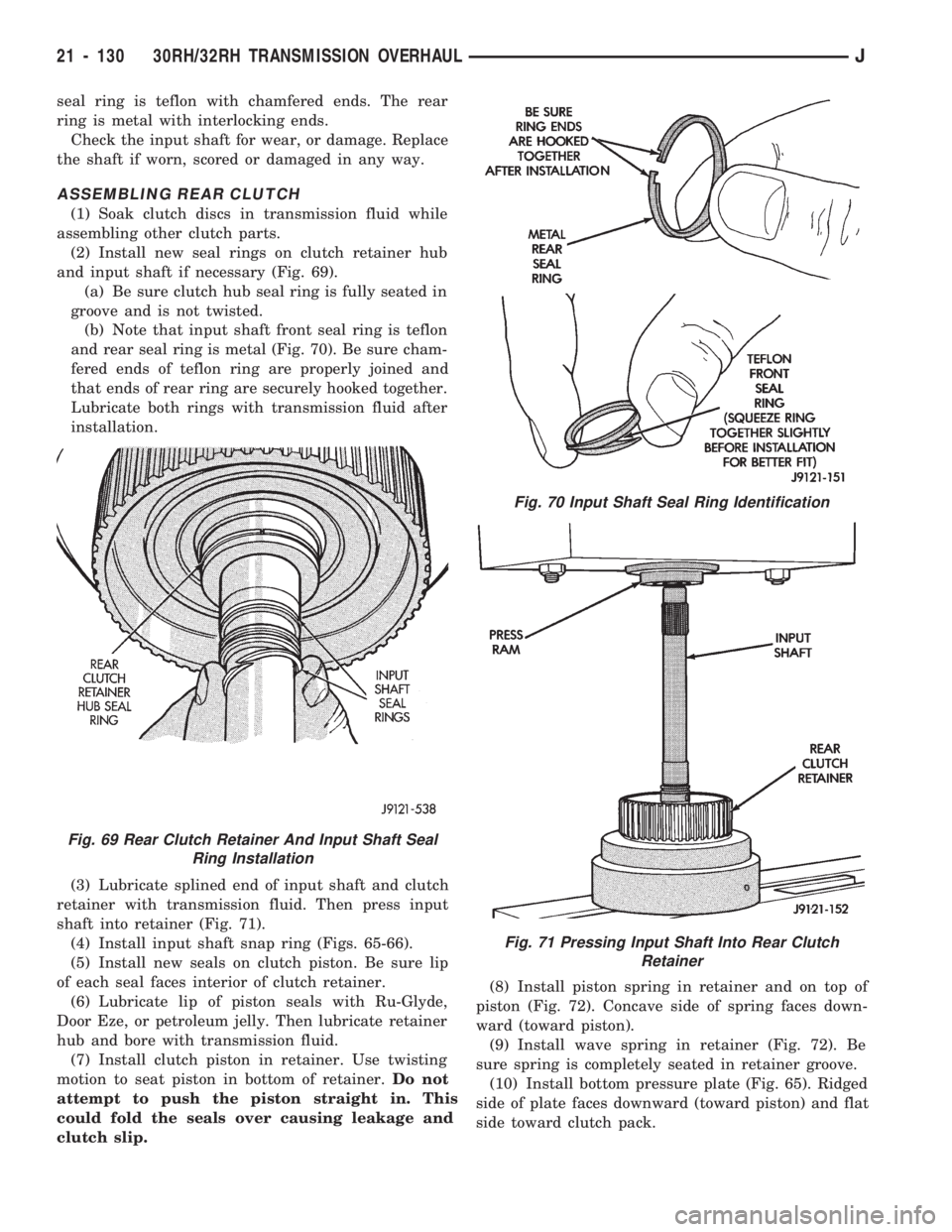
seal ring is teflon with chamfered ends. The rear
ring is metal with interlocking ends.
Check the input shaft for wear, or damage. Replace
the shaft if worn, scored or damaged in any way.
ASSEMBLING REAR CLUTCH
(1) Soak clutch discs in transmission fluid while
assembling other clutch parts.
(2) Install new seal rings on clutch retainer hub
and input shaft if necessary (Fig. 69).
(a) Be sure clutch hub seal ring is fully seated in
groove and is not twisted.
(b) Note that input shaft front seal ring is teflon
and rear seal ring is metal (Fig. 70). Be sure cham-
fered ends of teflon ring are properly joined and
that ends of rear ring are securely hooked together.
Lubricate both rings with transmission fluid after
installation.
(3) Lubricate splined end of input shaft and clutch
retainer with transmission fluid. Then press input
shaft into retainer (Fig. 71).
(4) Install input shaft snap ring (Figs. 65-66).
(5) Install new seals on clutch piston. Be sure lip
of each seal faces interior of clutch retainer.
(6) Lubricate lip of piston seals with Ru-Glyde,
Door Eze, or petroleum jelly. Then lubricate retainer
hub and bore with transmission fluid.
(7) Install clutch piston in retainer. Use twisting
motion to seat piston in bottom of retainer.Do not
attempt to push the piston straight in. This
could fold the seals over causing leakage and
clutch slip.(8) Install piston spring in retainer and on top of
piston (Fig. 72). Concave side of spring faces down-
ward (toward piston).
(9) Install wave spring in retainer (Fig. 72). Be
sure spring is completely seated in retainer groove.
(10) Install bottom pressure plate (Fig. 65). Ridged
side of plate faces downward (toward piston) and flat
side toward clutch pack.
Fig. 69 Rear Clutch Retainer And Input Shaft Seal
Ring Installation
Fig. 70 Input Shaft Seal Ring Identification
Fig. 71 Pressing Input Shaft Into Rear Clutch
Retainer
21 - 130 30RH/32RH TRANSMISSION OVERHAULJ
Page 1242 of 1784
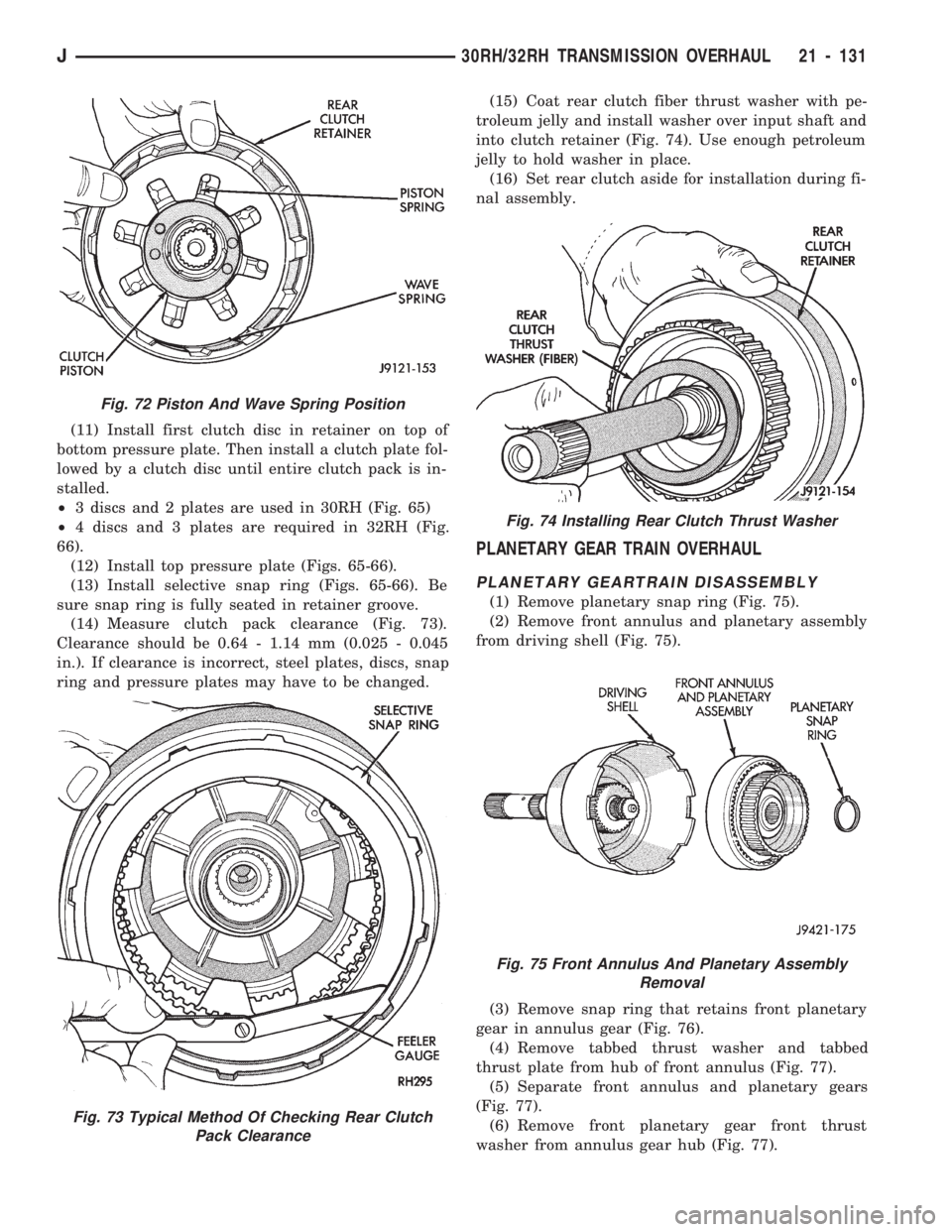
(11) Install first clutch disc in retainer on top of
bottom pressure plate. Then install a clutch plate fol-
lowed by a clutch disc until entire clutch pack is in-
stalled.
²3 discs and 2 plates are used in 30RH (Fig. 65)
²4 discs and 3 plates are required in 32RH (Fig.
66).
(12) Install top pressure plate (Figs. 65-66).
(13) Install selective snap ring (Figs. 65-66). Be
sure snap ring is fully seated in retainer groove.
(14) Measure clutch pack clearance (Fig. 73).
Clearance should be 0.64 - 1.14 mm (0.025 - 0.045
in.). If clearance is incorrect, steel plates, discs, snap
ring and pressure plates may have to be changed.(15) Coat rear clutch fiber thrust washer with pe-
troleum jelly and install washer over input shaft and
into clutch retainer (Fig. 74). Use enough petroleum
jelly to hold washer in place.
(16) Set rear clutch aside for installation during fi-
nal assembly.
PLANETARY GEAR TRAIN OVERHAUL
PLANETARY GEARTRAIN DISASSEMBLY
(1) Remove planetary snap ring (Fig. 75).
(2) Remove front annulus and planetary assembly
from driving shell (Fig. 75).
(3) Remove snap ring that retains front planetary
gear in annulus gear (Fig. 76).
(4) Remove tabbed thrust washer and tabbed
thrust plate from hub of front annulus (Fig. 77).
(5) Separate front annulus and planetary gears
(Fig. 77).
(6) Remove front planetary gear front thrust
washer from annulus gear hub (Fig. 77).
Fig. 72 Piston And Wave Spring Position
Fig. 73 Typical Method Of Checking Rear Clutch
Pack Clearance
Fig. 74 Installing Rear Clutch Thrust Washer
Fig. 75 Front Annulus And Planetary Assembly
Removal
J30RH/32RH TRANSMISSION OVERHAUL 21 - 131
Page 1243 of 1784
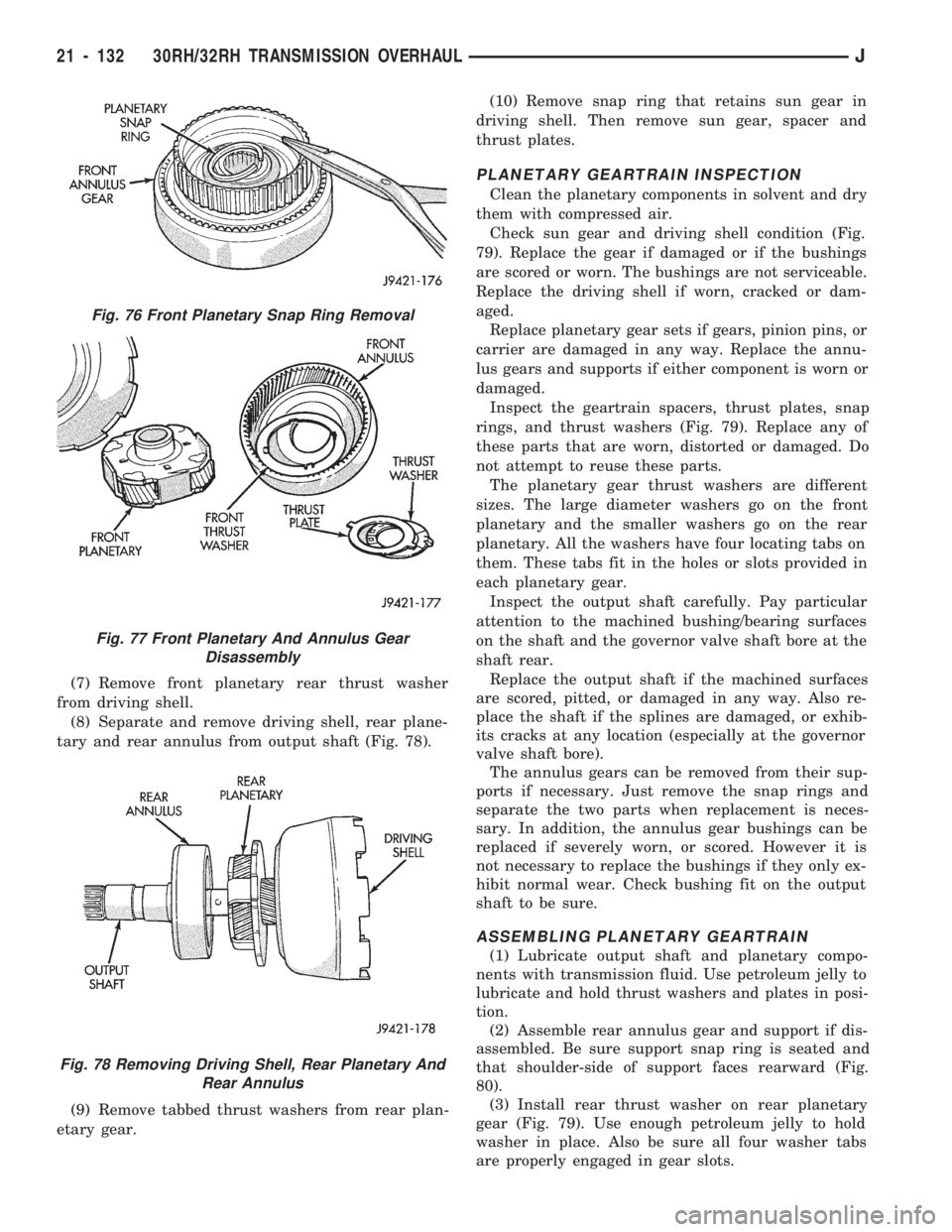
(7) Remove front planetary rear thrust washer
from driving shell.
(8) Separate and remove driving shell, rear plane-
tary and rear annulus from output shaft (Fig. 78).
(9) Remove tabbed thrust washers from rear plan-
etary gear.(10) Remove snap ring that retains sun gear in
driving shell. Then remove sun gear, spacer and
thrust plates.
PLANETARY GEARTRAIN INSPECTION
Clean the planetary components in solvent and dry
them with compressed air.
Check sun gear and driving shell condition (Fig.
79). Replace the gear if damaged or if the bushings
are scored or worn. The bushings are not serviceable.
Replace the driving shell if worn, cracked or dam-
aged.
Replace planetary gear sets if gears, pinion pins, or
carrier are damaged in any way. Replace the annu-
lus gears and supports if either component is worn or
damaged.
Inspect the geartrain spacers, thrust plates, snap
rings, and thrust washers (Fig. 79). Replace any of
these parts that are worn, distorted or damaged. Do
not attempt to reuse these parts.
The planetary gear thrust washers are different
sizes. The large diameter washers go on the front
planetary and the smaller washers go on the rear
planetary. All the washers have four locating tabs on
them. These tabs fit in the holes or slots provided in
each planetary gear.
Inspect the output shaft carefully. Pay particular
attention to the machined bushing/bearing surfaces
on the shaft and the governor valve shaft bore at the
shaft rear.
Replace the output shaft if the machined surfaces
are scored, pitted, or damaged in any way. Also re-
place the shaft if the splines are damaged, or exhib-
its cracks at any location (especially at the governor
valve shaft bore).
The annulus gears can be removed from their sup-
ports if necessary. Just remove the snap rings and
separate the two parts when replacement is neces-
sary. In addition, the annulus gear bushings can be
replaced if severely worn, or scored. However it is
not necessary to replace the bushings if they only ex-
hibit normal wear. Check bushing fit on the output
shaft to be sure.
ASSEMBLING PLANETARY GEARTRAIN
(1) Lubricate output shaft and planetary compo-
nents with transmission fluid. Use petroleum jelly to
lubricate and hold thrust washers and plates in posi-
tion.
(2) Assemble rear annulus gear and support if dis-
assembled. Be sure support snap ring is seated and
that shoulder-side of support faces rearward (Fig.
80).
(3) Install rear thrust washer on rear planetary
gear (Fig. 79). Use enough petroleum jelly to hold
washer in place. Also be sure all four washer tabs
are properly engaged in gear slots.
Fig. 76 Front Planetary Snap Ring Removal
Fig. 77 Front Planetary And Annulus Gear
Disassembly
Fig. 78 Removing Driving Shell, Rear Planetary And
Rear Annulus
21 - 132 30RH/32RH TRANSMISSION OVERHAULJ
Page 1244 of 1784
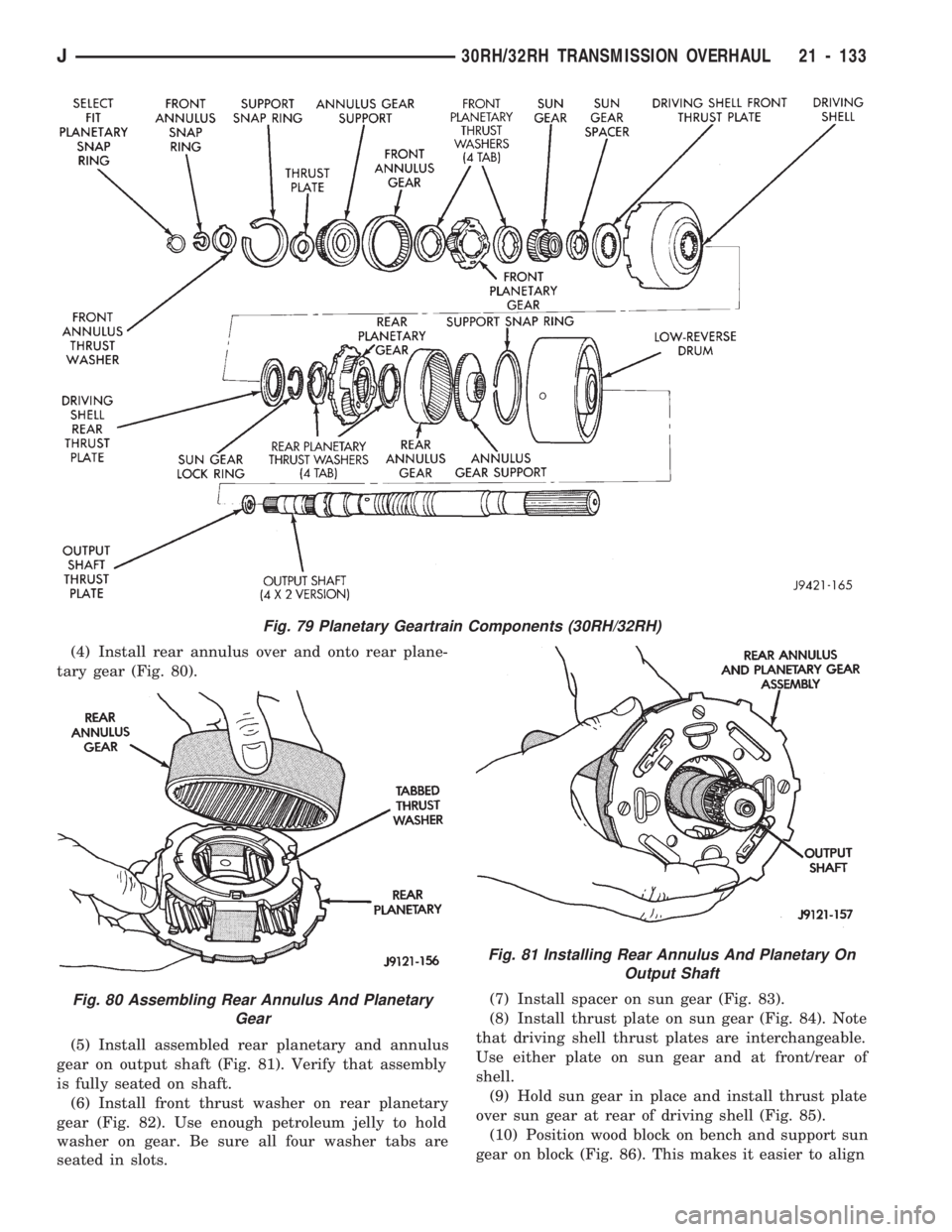
(4) Install rear annulus over and onto rear plane-
tary gear (Fig. 80).
(5) Install assembled rear planetary and annulus
gear on output shaft (Fig. 81). Verify that assembly
is fully seated on shaft.
(6) Install front thrust washer on rear planetary
gear (Fig. 82). Use enough petroleum jelly to hold
washer on gear. Be sure all four washer tabs are
seated in slots.(7) Install spacer on sun gear (Fig. 83).
(8) Install thrust plate on sun gear (Fig. 84). Note
that driving shell thrust plates are interchangeable.
Use either plate on sun gear and at front/rear of
shell.
(9) Hold sun gear in place and install thrust plate
over sun gear at rear of driving shell (Fig. 85).
(10) Position wood block on bench and support sun
gear on block (Fig. 86). This makes it easier to align
Fig. 79 Planetary Geartrain Components (30RH/32RH)
Fig. 80 Assembling Rear Annulus And Planetary
Gear
Fig. 81 Installing Rear Annulus And Planetary On
Output Shaft
J30RH/32RH TRANSMISSION OVERHAUL 21 - 133
Page 1245 of 1784
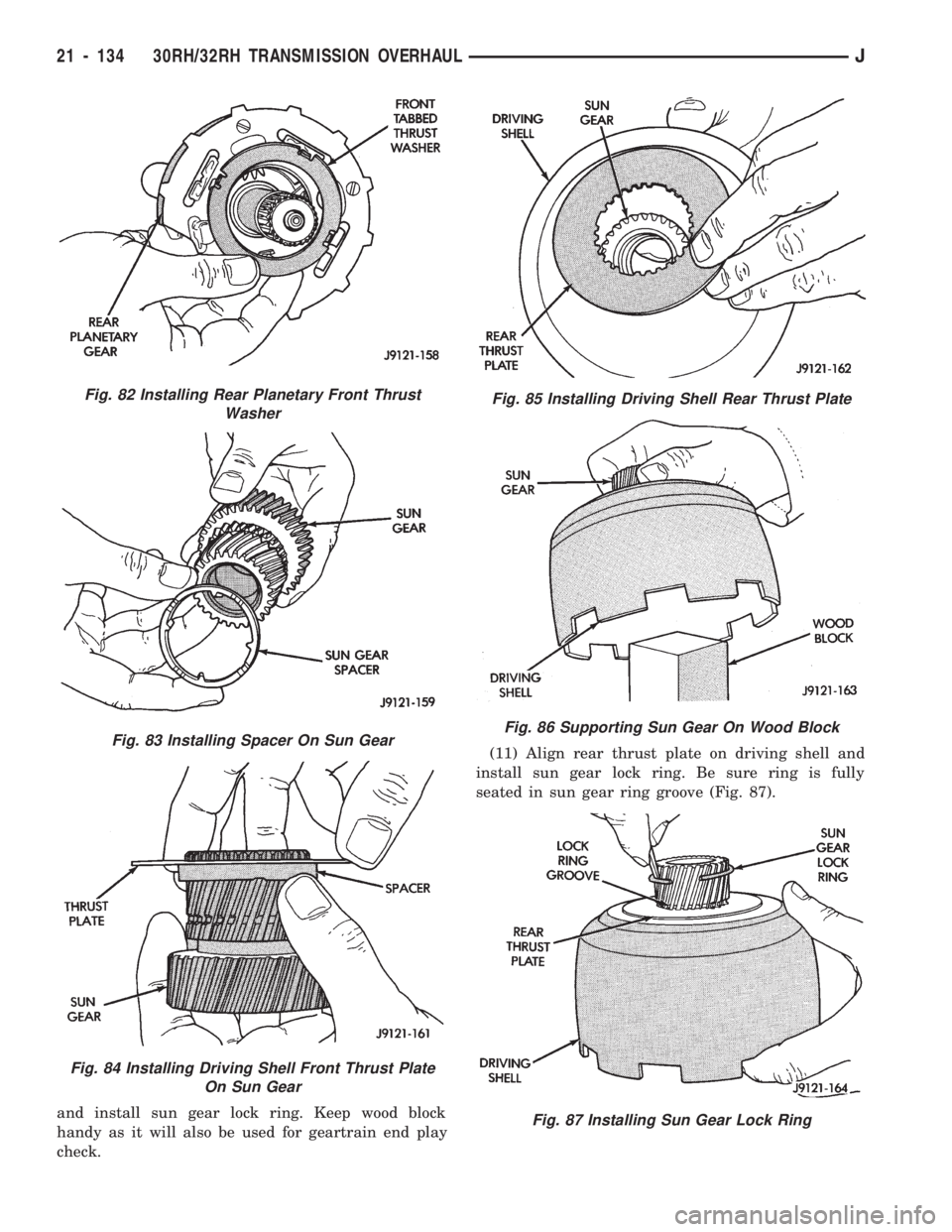
and install sun gear lock ring. Keep wood block
handy as it will also be used for geartrain end play
check.(11) Align rear thrust plate on driving shell and
install sun gear lock ring. Be sure ring is fully
seated in sun gear ring groove (Fig. 87).
Fig. 82 Installing Rear Planetary Front Thrust
Washer
Fig. 83 Installing Spacer On Sun Gear
Fig. 84 Installing Driving Shell Front Thrust Plate
On Sun Gear
Fig. 85 Installing Driving Shell Rear Thrust Plate
Fig. 86 Supporting Sun Gear On Wood Block
Fig. 87 Installing Sun Gear Lock Ring
21 - 134 30RH/32RH TRANSMISSION OVERHAULJ
Page 1246 of 1784
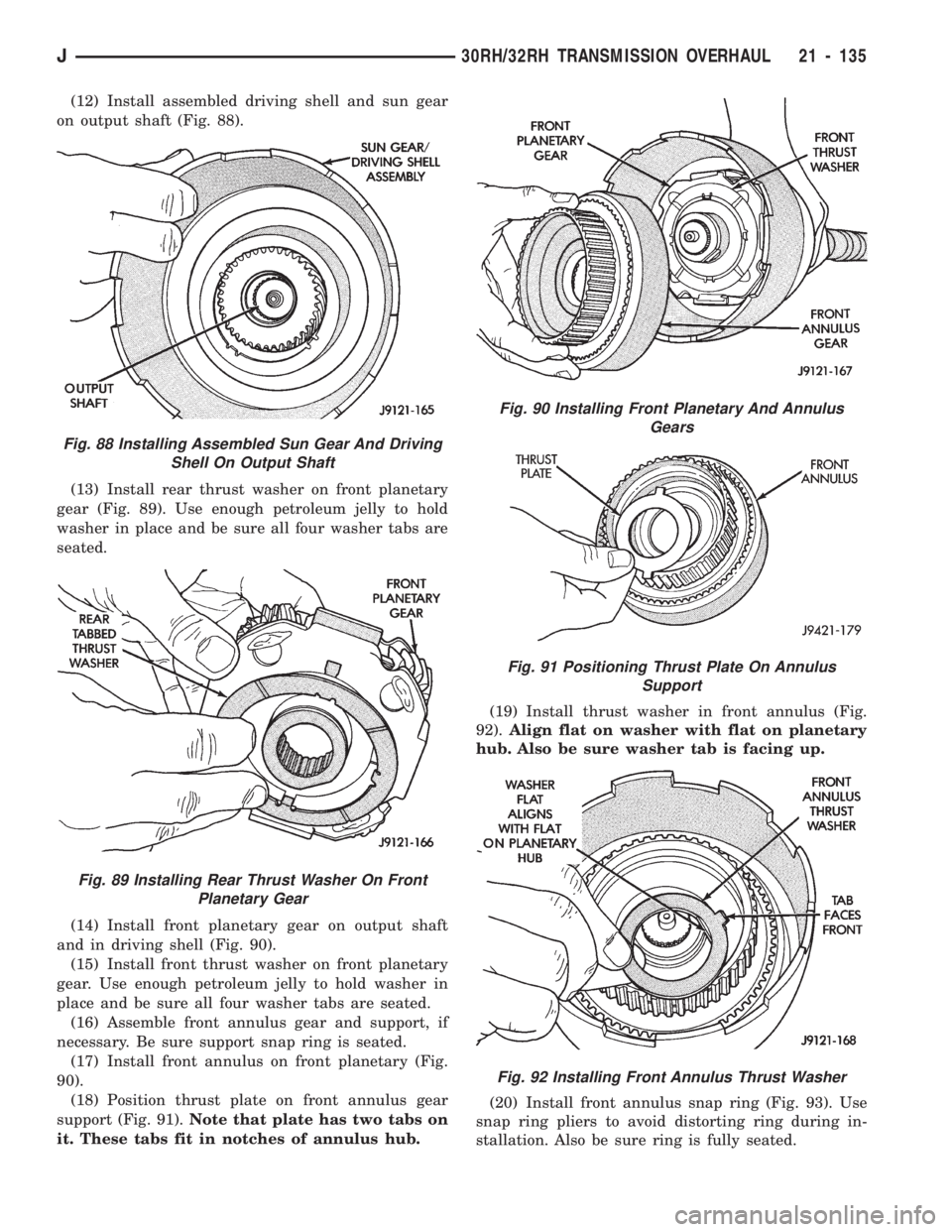
(12) Install assembled driving shell and sun gear
on output shaft (Fig. 88).
(13) Install rear thrust washer on front planetary
gear (Fig. 89). Use enough petroleum jelly to hold
washer in place and be sure all four washer tabs are
seated.
(14) Install front planetary gear on output shaft
and in driving shell (Fig. 90).
(15) Install front thrust washer on front planetary
gear. Use enough petroleum jelly to hold washer in
place and be sure all four washer tabs are seated.
(16) Assemble front annulus gear and support, if
necessary. Be sure support snap ring is seated.
(17) Install front annulus on front planetary (Fig.
90).
(18) Position thrust plate on front annulus gear
support (Fig. 91).Note that plate has two tabs on
it. These tabs fit in notches of annulus hub.(19) Install thrust washer in front annulus (Fig.
92).Align flat on washer with flat on planetary
hub. Also be sure washer tab is facing up.
(20) Install front annulus snap ring (Fig. 93). Use
snap ring pliers to avoid distorting ring during in-
stallation. Also be sure ring is fully seated.
Fig. 88 Installing Assembled Sun Gear And Driving
Shell On Output Shaft
Fig. 89 Installing Rear Thrust Washer On Front
Planetary Gear
Fig. 90 Installing Front Planetary And Annulus
Gears
Fig. 91 Positioning Thrust Plate On Annulus
Support
Fig. 92 Installing Front Annulus Thrust Washer
J30RH/32RH TRANSMISSION OVERHAUL 21 - 135
Page 1247 of 1784

(21) Install planetary selective snap ring with snap
ring pliers (Fig. 94). Be sure ring is fully seated.
(22) Turn planetary geartrain assembly over so
driving shell is facing workbench. Then support
geartrain on wood block positioned under forward
end of output shaft. This allow geartrain components
to move forward for accurate end play check.
(23) Check planetary geartrain end play with
feeler gauge (Fig. 95). Gauge goes between shoulder
on output shaft and end of rear annulus support.
(24) Geartrain end play should be 0.12 to 1.22 mm
(0.005 to 0.048 in.). If end play is incorrect, snap ring
(or thrust washers) may have to be replaced. Snap
ring is available in three different thicknesses for ad-
justment purposes.
FRONT SERVO AND BAND OVERHAUL
FRONT SERVO DISASSEMBLY (FIG. 96)
(1) Remove small snap ring from servo piston.
(2) Remove piston, rod, springs and guide.
(3) Remove and discard servo piston rings and
O-ring.
FRONT SERVO AND BAND INSPECTION
Clean the servo components with solvent and dry
them with compressed air.
Inspect the servo components. Replace the springs
if collapsed, distorted or broken. Replace the guide,
rod and piston if cracked, bent, or worn. Discard the
servo snap ring if distorted or warped.
Replace the front band if distorted, the lining is
burned or flaking off, or excessively worn.
Check the servo piston bore for wear. Replace the
piston and rod as an assembly if either part is worn
or damaged.
Replace any servo component if doubt exists about
its condition. Do not reuse suspect parts.
ASSEMBLING FRONT SERVO PISTON
(1) Lubricate servo parts with transmission fluid.
(2) Install new O-ring on servo piston rod.
(3) Install new seal on piston rod guide and install
new seal rings on piston.
(4) Assemble rod, piston, servo springs and snap
ring (Fig. 96).
REAR SERVO AND BAND OVERHAUL
REAR SERVO PISTON DISASSEMBLY
(1) Remove seal from servo piston. Note which way
seal lip faces for assembly reference.
(2) Compress cushion spring in vise only enough to
allow piston plug snap ring removal (Fig. 97). Use
wood block between vise jaws and end of piston plug
to keep plug aligned and in position.
(3)
Remove snap ring from end of piston plug (Fig. 97).
(4) Open vise and remove wood block, piston plug,
cushion spring and servo piston.
Fig. 93 Installing Front Annulus Snap Ring
Fig. 94 Installing Planetary Selective Snap Ring
Fig. 95 Checking Planetary Geartrain End Play
21 - 136 30RH/32RH TRANSMISSION OVERHAULJ
Page 1248 of 1784
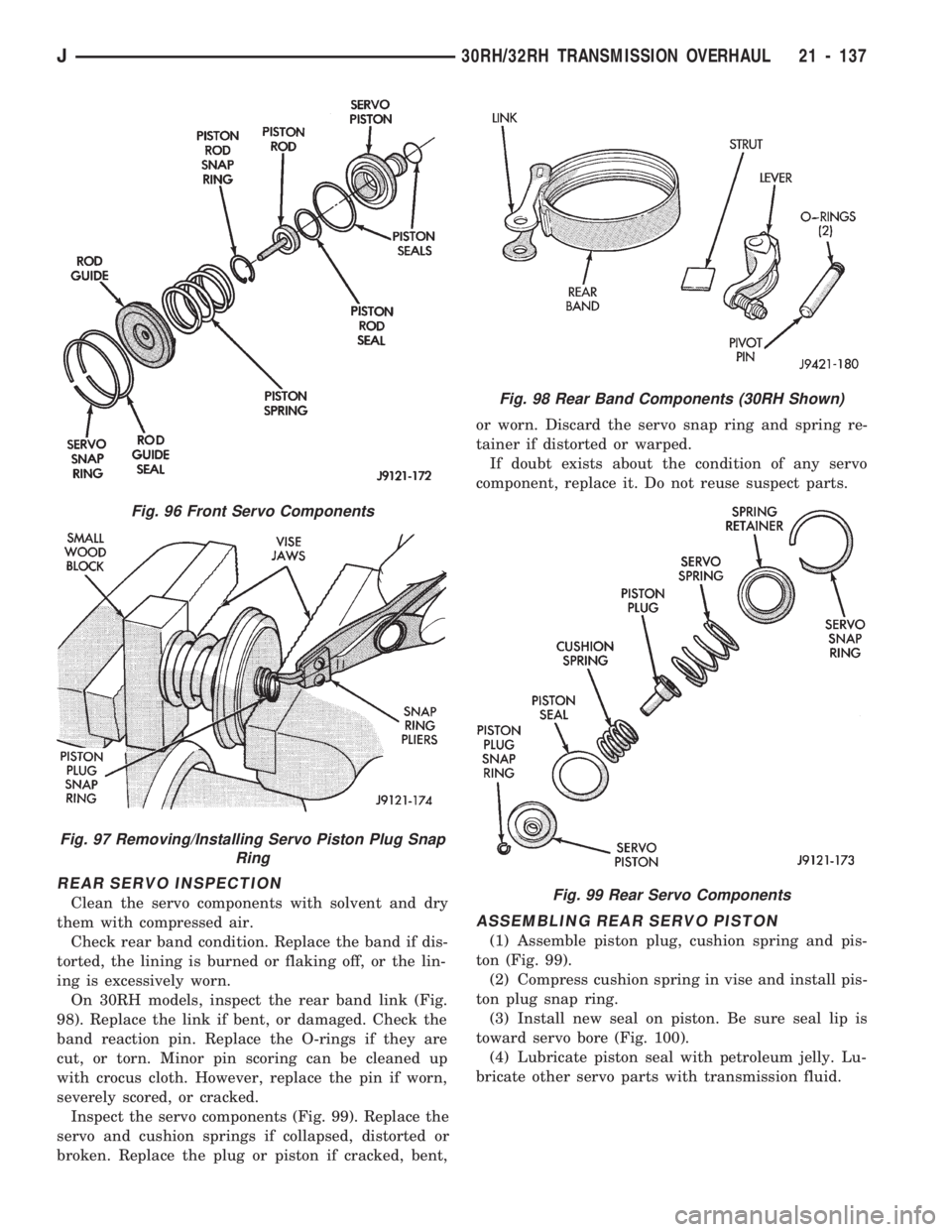
REAR SERVO INSPECTION
Clean the servo components with solvent and dry
them with compressed air.
Check rear band condition. Replace the band if dis-
torted, the lining is burned or flaking off, or the lin-
ing is excessively worn.
On 30RH models, inspect the rear band link (Fig.
98). Replace the link if bent, or damaged. Check the
band reaction pin. Replace the O-rings if they are
cut, or torn. Minor pin scoring can be cleaned up
with crocus cloth. However, replace the pin if worn,
severely scored, or cracked.
Inspect the servo components (Fig. 99). Replace the
servo and cushion springs if collapsed, distorted or
broken. Replace the plug or piston if cracked, bent,or worn. Discard the servo snap ring and spring re-
tainer if distorted or warped.
If doubt exists about the condition of any servo
component, replace it. Do not reuse suspect parts.
ASSEMBLING REAR SERVO PISTON
(1) Assemble piston plug, cushion spring and pis-
ton (Fig. 99).
(2) Compress cushion spring in vise and install pis-
ton plug snap ring.
(3) Install new seal on piston. Be sure seal lip is
toward servo bore (Fig. 100).
(4) Lubricate piston seal with petroleum jelly. Lu-
bricate other servo parts with transmission fluid.
Fig. 96 Front Servo Components
Fig. 97 Removing/Installing Servo Piston Plug Snap
Ring
Fig. 98 Rear Band Components (30RH Shown)
Fig. 99 Rear Servo Components
J30RH/32RH TRANSMISSION OVERHAUL 21 - 137
Page 1249 of 1784
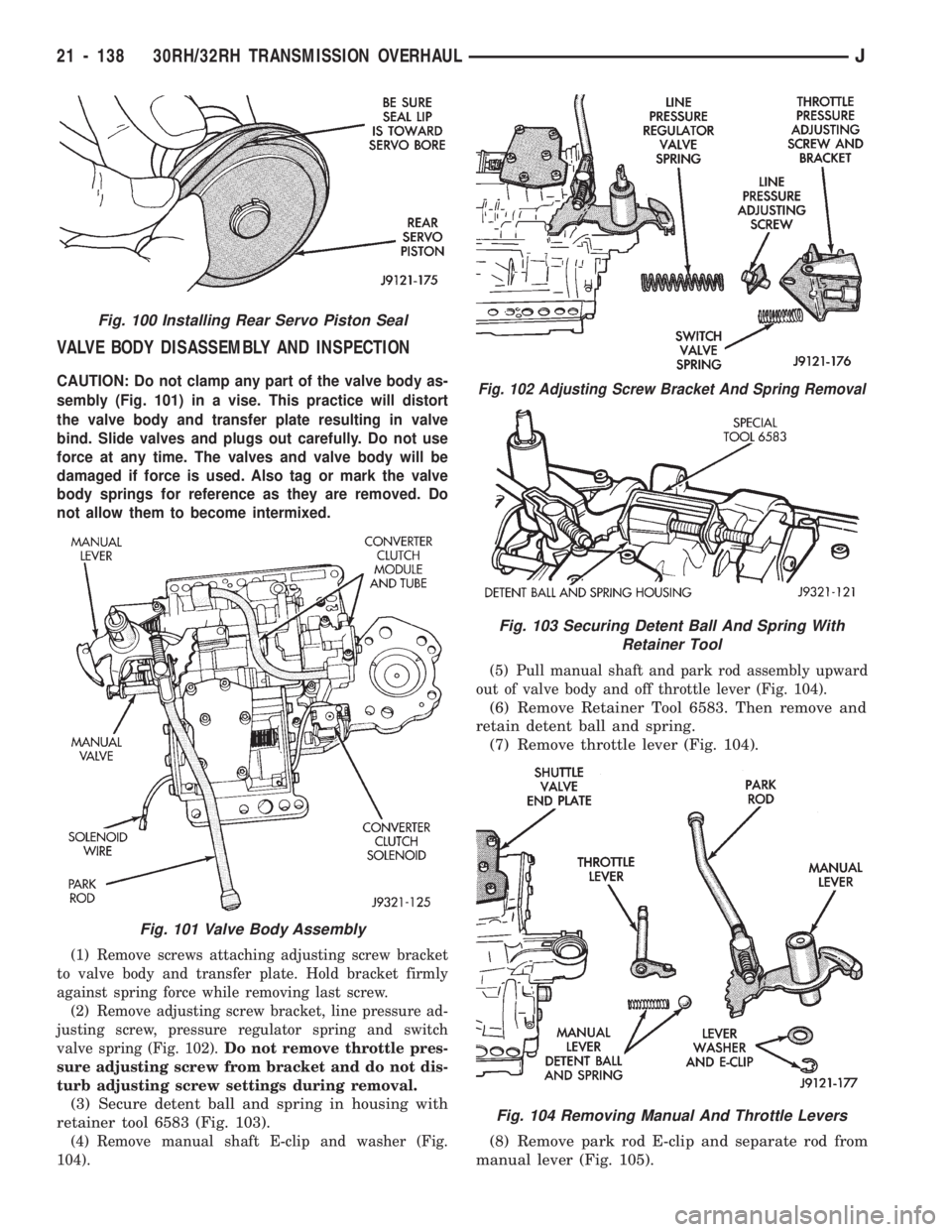
VALVE BODY DISASSEMBLY AND INSPECTION
CAUTION: Do not clamp any part of the valve body as-
sembly (Fig. 101) in a vise. This practice will distort
the valve body and transfer plate resulting in valve
bind. Slide valves and plugs out carefully. Do not use
force at any time. The valves and valve body will be
damaged if force is used. Also tag or mark the valve
body springs for reference as they are removed. Do
not allow them to become intermixed.
(1) Remove screws attaching adjusting screw bracket
to valve body and transfer plate. Hold bracket firmly
against spring force while removing last screw.
(2) Remove adjusting screw bracket, line pressure ad-
justing screw, pressure regulator spring and switch
valve spring (Fig. 102).Do not remove throttle pres-
sure adjusting screw from bracket and do not dis-
turb adjusting screw settings during removal.
(3) Secure detent ball and spring in housing with
retainer tool 6583 (Fig. 103).
(4) Remove manual shaft E-clip and washer (Fig.
104).(5) Pull manual shaft and park rod assembly upward
out of valve body and off throttle lever (Fig. 104).
(6) Remove Retainer Tool 6583. Then remove and
retain detent ball and spring.
(7) Remove throttle lever (Fig. 104).
(8) Remove park rod E-clip and separate rod from
manual lever (Fig. 105).
Fig. 102 Adjusting Screw Bracket And Spring Removal
Fig. 103 Securing Detent Ball And Spring With
Retainer Tool
Fig. 104 Removing Manual And Throttle Levers
Fig. 100 Installing Rear Servo Piston Seal
Fig. 101 Valve Body Assembly
21 - 138 30RH/32RH TRANSMISSION OVERHAULJ
Page 1250 of 1784
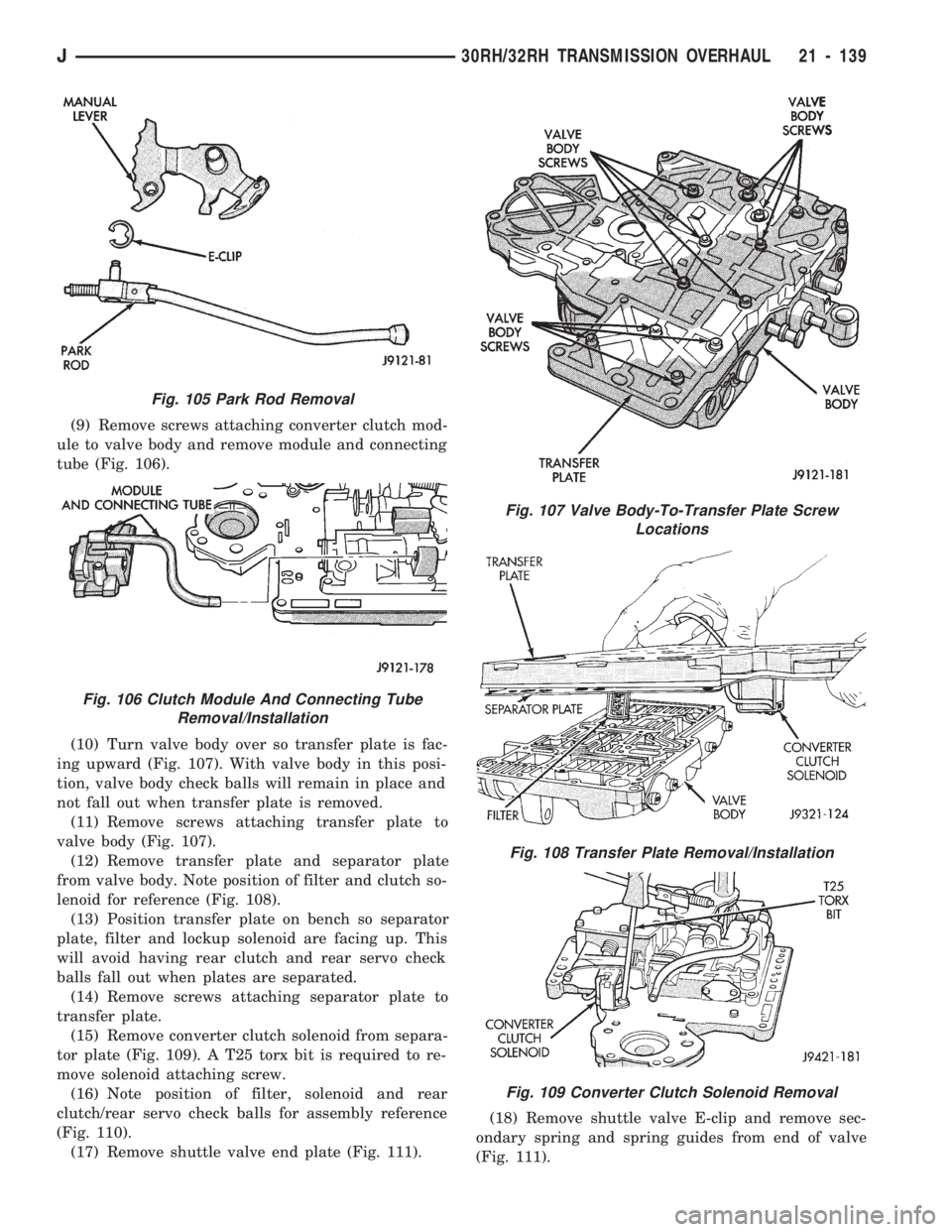
(9) Remove screws attaching converter clutch mod-
ule to valve body and remove module and connecting
tube (Fig. 106).
(10) Turn valve body over so transfer plate is fac-
ing upward (Fig. 107). With valve body in this posi-
tion, valve body check balls will remain in place and
not fall out when transfer plate is removed.
(11) Remove screws attaching transfer plate to
valve body (Fig. 107).
(12) Remove transfer plate and separator plate
from valve body. Note position of filter and clutch so-
lenoid for reference (Fig. 108).
(13) Position transfer plate on bench so separator
plate, filter and lockup solenoid are facing up. This
will avoid having rear clutch and rear servo check
balls fall out when plates are separated.
(14) Remove screws attaching separator plate to
transfer plate.
(15) Remove converter clutch solenoid from separa-
tor plate (Fig. 109). A T25 torx bit is required to re-
move solenoid attaching screw.
(16) Note position of filter, solenoid and rear
clutch/rear servo check balls for assembly reference
(Fig. 110).
(17) Remove shuttle valve end plate (Fig. 111).(18) Remove shuttle valve E-clip and remove sec-
ondary spring and spring guides from end of valve
(Fig. 111).
Fig. 105 Park Rod Removal
Fig. 106 Clutch Module And Connecting Tube
Removal/Installation
Fig. 107 Valve Body-To-Transfer Plate Screw
Locations
Fig. 108 Transfer Plate Removal/Installation
Fig. 109 Converter Clutch Solenoid Removal
J30RH/32RH TRANSMISSION OVERHAUL 21 - 139